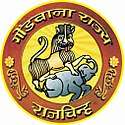Garha Kingdom
| Garha Kingdom of Gondwana | |
|---|---|
| 4th century–18th century | |
 Flag | |
| Capital |
Garha Singhorgarh Chouragarh Ramnagar Mandla |
| Common languages |
Sanskrit Gondwani |
| Religion | Hinduism |
| Government | Monarchy |
| History | |
• Established | 4th century |
• Disestablished | 18th century |
| Today part of |
|
The Garha Kingdom, also called Garha Mandla[1] or Garha Katanga. It was northern part of Gondwana.
History
Garha-Katanga kingdom was founded by Yadavrai in 358 BC, as per an inscription in the palace of Ramnagar. The rule of Rajgond dynasty started in the 4th century. The Garha-Mandla kingdom was earlier a small territory which witnessed rapid expansion under the rule of Sangram Shah, the 48th king, He captured territories like Narmada Valley, Bhopal, Sagar, Damoh and most of the Satpura hills. However the Garha-Mandla kings' rule ended when Asaf Khan I, the Mughal Viceroy, invaded the kingdom in 1564. The Gond Queen Rani Durgavati is said to have fought bravely against King Akbar to save her kingdom; The Mughals acquired immense booty, including thousands of elephants from this victory. At the beginning of the year 1742 the Peshwas invaded Mandla and extracted chauth (tribute) from the region. Finally, with the end of Rajgond dynasty, Garha-Mandla was annexed to the Maratha government in the year 1781.
The greatest ruler was Sangram Shah. He was 48th ruler of Garha Kingdom who had conquered 52 forts called Garh to strengthen and spread the Gond Empire. The Chouragrh Fort in Narsinghpur was built on the honour of conquering 52 forts. Sangram Shah is best known as a patron of arts and literature and he had great knowledge of Sanskrit. Rasratnamala was written by Sangram Shah. At the time of Sangram Shah the capital of Garha kingdom was Singhorgarh.
His son Dalpat Shah was married to Rani Durgawati[2] who was a Chandel princess. Rani Durgavati moved her capital to Chouragarh because it was safer than Singhorgarh. Rani Durgawati is the known for the bravery and sacrifice for her country. She battled against Mughal Empire of Akbar lead by Asaf khan.
Hridayshah was the music lover. He was 54th ruler of Garha Kingdom. He gave his contributions for music. Hriday koutuk and Hriday prakash were written by him. He moved his capital from Chouragarh to Ramnagar of Mandla district.
Shankar Shah and Raghunath Shah were freedom fighters who revolted against the British in the Indian Rebellion of 1857.
Administration
Administration of Gondwana was becoming centralised. The kingdom was divided into garh , each garh was controlled by perticuler gond clan . This was ferthur divided into units of 84 villages called chourasi. The chourasi was further subdivided into barhots which are made up of 12 villages each.
Genealogy
The genealogy of rulers of Garha Kingdom is recorded in the Ramnagar Inscription at Ramnagar Fort (Mandla).[3]
| Genealogy of Rajgond rulers of Garha Kingdom | ||||||||||||||||||||||||||||||||||||||||||||||||||||||||||||||||||||||||||||||||||||||||||||||||||||||||||||||||||||||||||||||||||||||||||||||||||||||||||||||||||||||||||||||||||||||||||||||||||||||||||||||||||||||||||||||||||||||||||||||||||||||||||||||||
52 Garh of Gondwana
References
| ||||||||||||||||||||||||||||||||||||||||||||||||||||||||||||||||||||||||||||||||||||||||||||||||||||||||||||||||||||||||||||||||||||||||||||||||||||||||||||||||||||||||||||||||||||||||||||||||||||||||||||||||||||||||||||||||||||||||||||||||||||||||||||||||